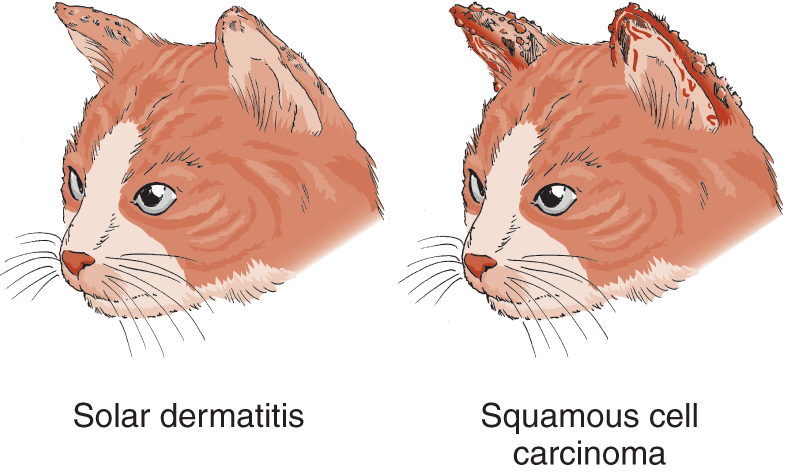Disorders of the Outer Ear in Cats
- Ear Disorders of Cats
- Ear Structure and Function in Cats
- Deafness in Cats
- Disorders of the Outer Ear in Cats
- Otitis Externa in Cats
- Otitis Media and Interna in Cats
- Tumors of the Ear Canal in Cats
Also see professional content regarding diseases of the pinna.
A variety of skin conditions affect the outside part of the ear, called the pinna. Most conditions cause tissue changes elsewhere as well. Rarely, a disease affects the outer ear alone or affects it first. As with all skin conditions, a diagnosis is best made when combined with the results of a thorough history, a complete physical and skin examination, and carefully selected diagnostic tests.
Insects and parasites commonly cause inflammation of the pinna—resulting in redness, swelling, itching or blistering—either through direct damage from the bite of the parasite or as a result of hypersensitivity.
Ear Hematomas
Ear hematomas are fluid-filled swellings that develop on the inward curving surface of the pinna (outer ear). The cause for their development is unknown. Signs include head shaking or ear scratching due to itchiness. Treatment usually involves surgery to drain and flush the swellings. Frequently, the veterinarian will place a drain made out of a soft tube in the area to help prevent fluid from building up again.
Immune-mediated Diseases
Several immune-mediated diseases may affect the outer ear and the ear canal. Other areas of the body are typically affected at the same time and may include footpads, mucous membranes, skin and mucous membrane junctions, nails and nail beds, and the tip of the tail. Immune-mediated diseases are confirmed using a biopsy of primary lesions.
Mange
Mange is caused by microscopic mites. There are several types of mites that cause mange. One of the most common types of inflammation of the external ear canal (otitis externa) in cats is otodectic mange, caused by Otodectes cynotis mites. The mites affect the skin as well as the ears, and signs include redness, partial loss of hair, itching, and general inflammation of the skin. It may occur on the head, neck, rump, or paws.
Sarcoptic mange, caused by the parasitic mite Sarcoptes scabiei is rare in cats. The condition begins with small, hard round bumps on the skin. These bumps progress to scaling, crusting, and raw, irritated areas on the ear edges and other parts of the body. Itching is severe. Transmission is by direct contact with infected animals.
Notoedric mange is also rare in cats, but can cause intense, constant itching around the ears, head, and neck. Signs include head-shaking, redness, hair loss, and crusted, grayish-yellow scabs.
The diagnosis of mange is based on signs, history of exposure, examination, and discovery of mites on multiple skin scrapings. The actual mites are small and hard to see, even with magnification. Treatment options include dips, medications effective against mites (applied to the skin or given by mouth or by injection). Corticosteroids may be given to help control severe itching. Your veterinarian will be able to prescribe the best treatment for your pet. Because mites can survive off the host for a variable amount of time, all bedding, brushes, and objects in your cat’s environment should be thoroughly cleaned. Any other cats or dogs in the household should be considered infested and should also be treated.
Mosquitoes
An allergic reaction to mosquito bites can cause an inflammation of the skin with crusted, slow-healing sores on the outer ears, nose, and rarely the footpads and eyelids of cats. Often referred to as miliary dermatitis, these tiny “millet seed” eruptions will crust over, ooze, then dry, leaving a small patch of hair loss. In severely affected cats, the affected areas progress from small, hard round bumps to raised, white to pink tumors to crusted, slow-healing sores that merge together to affect extensive areas. The amount of itching varies and lymph nodes may enlarge. Treatment includes keeping the cat inside and using a prescribed insect repellent when exposure to mosquitoes is anticipated. Be sure to use only repellents prescribed by your veterinarian.
Solar Dermatitis (Radiation Dermatitis)
Feline solar dermatitis, also called radiation or ultraviolet dermatitis is seen most commonly in white cats or cats with white outer ears that have had longterm exposure to the sun. The first signs are a reddening of the skin and scaling on the sparsely-haired tips of the ears. Crusting, discharge, and slow-healing sores may develop as the hornlike growth on the skin undergoes transformation into a form of cancer called squamous cell carcinoma. During early stages of the disease, treatment consists of limiting exposure to sunlight through confinement indoors between the hours of 10 a.m. and 4 p.m., and the use of special topical sunscreens that your veterinarian will prescribe. Squamous cell carcinoma of the outer ears is treated with surgical removal followed by radiation treatment.
Ticks
Ticks can cause irritation at the site of attachment and may be found on the pinna or in the ear canal. The ear tick, found in the southwestern United States, South and Central Americas, southern Africa, and India, is a soft-shelled tick whose younger, immature forms infest and live on the external ear canal of cats and other animals. Signs include head shaking, head rubbing, or attempts to scratch the ear. Both the animal and the environment (including all bedding) should be treated using the compounds prescribed or recommended by your veterinarian.
- Ear Disorders of Cats
- Ear Structure and Function in Cats
- Deafness in Cats
- Disorders of the Outer Ear in Cats
- Otitis Externa in Cats
- Otitis Media and Interna in Cats
- Tumors of the Ear Canal in Cats






